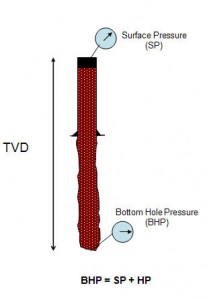This post will show you Lean about bottom hole pressure relationship because this concept is very important for well control concept.
The bottom hole pressure is sum of all the pressure acting on the bottom hole. We can describe the statement before as the following equation;
Bottom Hole Pressure (BHP) = Surface Pressure (SP) + Hydrostatic Pressure (HP)
The image below demonstrates the relationship of bottom hole pressure.

Note: BHP created by hydrostatic column of drilling fluid is the primary well control in drilling.
Looking more into details,
If BHP is more than FP (formation pressure), this situation is called "Overbalance".
If BHP is equal to FP (formation pressure), this situation is called "Balance".
If BHP is less than FP (formation pressure), this situation is called "Underbalance".
For more understanding, please follow this example below demonstrating the relationship of BHP, SP and HP.
Bottom Hole Pressure (BHP) = Surface Pressure (SP) + Hydrostatic Pressure (HP)
We assume that formation pressure is normal pressure gradient of water gradient (0.465 psi/ft) so formation pressure at 8000' TVD = 8000 ft x 0.465 psi/ft = 3720 psi. We need to learn how to calculate hydrostatic pressure in oilfield.
The first case: Hydrostatic column is water which is equal to formation pressure gradient so SP is equal to 0 psi
The second case: BHP is still be water gradient but fluid column is oil (0.35 psi/ft) which is lower density than water gradient (0.465 psi/ft). Therefore, in order to balance BHP, we need Surface Pressure (SP) of 920 psi (SP = 3720 – (0.35 x 8000)).
The third case: BHP is still be water gradient but fluid column is gas (0.1 psi/ft) which is even lower density than water gradient (0.465 psi/ft). Therefore, in order to balance BHP, we need Surface Pressure (SP) of 2,920 psi (SP = 3720 – (0.1 x 8000)).
According to the example, Surface Pressure (SP) will compensate the lack of hydrostatic pressure (HP) in order to balance formation pressure (FP).















No comments:
Post a Comment